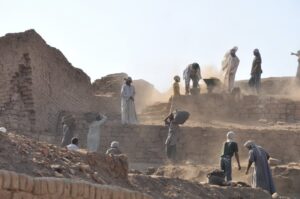I don’t remember much about the sixth grade, but I vividly remember a field trip to Thunderbird Archaeological Dig in Warren County. Mrs. Josephine Lynn transmitted her love for history and geography to many of her students and planned this special outing for us to experience the work of archaeologists digging up Native American history right in our own back yard.
That trip was just one of the sparks that fueled my interest in the past and the fascination for whatever various artifacts can tell us. More recently, I’ve enjoyed books, magazines, and documentaries that feature the latest in archeological discoveries from China, South America, and around the globe.
Because it is the crossroads of the world, the Middle East has also been the location of many excavations and much research. Layer upon layer of civilization is mounded up at numerous spots throughout the region and archeologists labor daily to discover what is yet hidden in the dirt.
One truth that is becoming more and more clear from all of their diligent work is how reliable and accurate the Bible is. Once dismissed as an outdated and fictitious account of ancient man, time and again its geography, history, and accuracy have been affirmed by plentiful artifacts and evidence.
Let’s take the Hittite people for example, first mentioned in Genesis particularly in connection with Abraham. The Bible speaks of the Hittites some 61 times but for many years no evidence of their existence was known. Many professors and historians who accepted most other ancient historical accounts without question even concluded that these people never existed and were a figment of the Biblical authors’ imaginations.
That is until 1906 when the ancient Hittite capital city of Hattusha was discovered in modern day Turkey and over 30,000 texts were found documenting not only their existence, but their dominance in the region for centuries. Ironically, one can even earn a degree in Hittite civilization today from various universities that once dismissed the possibility of its very existence.
If that were the only instance, it could be considered coincidence, but there is a growing tsunami of such evidence for other pages of the Bible as well. The “experts” long taught that King David was a legend fabricated to generate Jewish pride until 1993 when a stone slab from about 850BC was unearthed that clearly referred to the “House of David.” What makes this even more astonishing is that it was recorded by one of Israel’s enemies within a hundred or so years of when this iconic ruler actually reigned. Skeptical historians and theologians had to backpedal and reluctantly acknowledge the indisputable evidence.
Earlier this year, the discovery was made of a significant bulla, which is a hardened piece of clay impressed with someone’s seal. The fascinating aspect of this particular bulla is that it bore the name Isaiah and was found not ten feet from a bulla of King Hezekiah who ruled at the time of Isaiah’s ministry. Although some disagreement persists, many authorities are convinced this is the actual seal of the prophet who so vividly described Jesus’ suffering and death over 700 years before He was even born.
Altogether, over fifty specific persons from the Bible have been verified by archeological discoveries from famous kings to insignificant scribes. No other ancient text has the enormous weight of concrete evidence to affirm it, yet it is still discounted and dismissed as antiquated fiction by those who want to evade its spiritual and moral implications.
Future columns will explore more of the evidence of the Bible’s veracity as proven by external sources. In the meantime, we can be more assured than ever that this bestselling book is not just challenging, comforting, and convicting, but that it is true from cover to cover. As Paul tells his protégé Timothy, “All Scripture is God-breathed and is useful for teaching, rebuking, correcting and training in righteousness, (2 Tim 3:16.)” We continue to discover from Middle Eastern soil that what God breathed is without error.
Since the Bible is true historically, let us also believe and obey it spiritually and recognize that Abraham, David, Isaiah and all others therein point directly to the book’s main subject and message, Jesus Christ, the Savior who died to redeem every person. If you haven’t already, put your trust in Him today!
Blessings, George